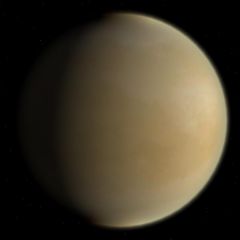Venus
Venus is the second planet from the Sun. It has a day longer than a year. The year length of Venus is 225 Earth days. The day length of Venus is 243 Earth days. It is a terrestrial planet because it has a solid, rocky surface like other planets in the inner solar system. Astronomers have known Venus for thousands of years. The ancient Romans named it after their goddess Venus. Venus is the brightest thing in the night sky except for the Moon. It is sometimes called the morning star or the evening star as at some elongations it is easily seen just before the sun comes up in the morning and, at other elongations, just after the sun goes down in the evening. Venus comes closer to the Earth than any other planet does.
Venus is sometimes called the sister planet of Earth as they are quite similar in size and gravity. In other ways, the planets are very different. Venus' atmosphere (air) is mostly carbon dioxide with clouds of sulphuric acid. Sulphuric acid is a chemical that is very poisonous to humans.
The thick atmosphere has made it hard to see the surface, and until the twenty-first century, many people thought things might live there. The pressure on Venus' surface is 92 times that of Earth. Venus has no moons. Venus spins very slowly on its axis and it spins in the opposite direction to the other planets.
Surface features
Although Venus is modeled as a sphere, there are more than 2000 surface features marked on Venus and are labeled if the labels are turned on in the Display menu.
See List of surface features on Venus
Historical missions to Venus
For a complete list of historical missions, see Missions to Venus.
Venus add-ons
Topography and Textures
- Lo Res Planets (for slow computers) released 18 December 2004 by unknown author.
- Venus HiRes Level 8 released 1 December 2009 by unknown author.
- Vega1 & Vega2 released 28 September 2010 by BrianJ.
- Venus 8 level texture released 5 March 2011 by sergsh.
- Venus Heightmap released 4 November 2012 by 4throck.
- Venus Level 9 global textures released 24 November 2012 by 4throck.
- Venus surface and heightmap tiles for Orbiter 2016 released 4 December 2016 by 4throck.
Missions to Venus and Venus bases
- GEP - Magellan historic mission to Venus released 17 June 2004 by missleman01.
- GEP - Galileo historic mission to Jupiter using a Venus flyby released 18 June 2004 by missleman01.
- GEP - Mariner 10 historic mission to Mercury using a Venus flyby released 19 June 2004 by missleman01.
- GEP- Cassini-Huygens V 1.2 historic mission to Saturn using a Venus flyby released 25 June 2004 by missleman01.
- Emissary Galleon v2 ficticious released 1 June 2005 by perseus.
- OP Center Farenheit ficticious base released 19 January 2006 by unknown author.
- Solar System Bases V7.0 Final ficticious bases released 21 January 2006 by unknkown author.
- Floating Base Titan-Venus v0.9 ficticious mission released 23 April 2006 by Peaceman.
- Venusbase ficticious base released 29 May 2006 by unknown author.
- The Double Planet Solar System ficticious situation released 9 July 2006 by ijuin.
- Venera-D historic mission released 9 December 2006 by Kodiak.
- 145 Year Solar System Tour ficticious mission released 28 February 2007 by unknown author.
- Venus Star v 0.5, a fictional spacecraft in Venus orbit released 6 November 2007 by Tsynique.
- Venus Express historic mission released 25 June 2008 by MartySpaceLines.
- Shukra_Venus_Station_080813 released 12 August 2008 by Artlav.
- Io Orbiter mission to Io using Venus flyby released 25 December 2008 by Piper.
- Venera 9 historic mission released 5 October 2009 by 4throck.
- Grand Exploration Probes- Mariner 2 historic mission released 22 May 2011 by Felipi1205.
- GEP Mariner 2 historic mission released 23 May 2011 by Felipi1205.
- Pioneer Venus 1 historic mission released 5 March 2012 by TheXFiles19.
- NASA - Titan Odyssey 1.0 released 12 October 2012 by ionif.
- NASA - Titan Odyssey 2.0 released 13 October 2012 by ionif.
- Flug zur Venus (Flight to Venus) ficticious mission released 17 April 2014 by drummer054.
- Venus Base released 17 April 2014 by drummer054.
- Multiple slingshot scenarios to outer planets released 29 August 2016 by downloaderfan.
- STS-30 (Atlantis) and Magellan historic mission launch released 10 August 2020 by Gargantua2024.
Miscellaneous
- Topographic Green Images for Map MFD released 15 February 2005 by Drake.
Flight Warning!
At the surface of Venus, the atmospheric pressure is 9.2MPa, over 90 atmospheres. This is substantially greater than the back-pressure which standard rocket motors are able to generate; a Delta-glider landed on Venus will not be able to take off (at least if the complex flight model is in use).
See Also
- Venus at Wikipedia.
| edit The Solar System | |
|---|---|
| Central star |
Sun (Sol) |
| Planets |
Mercury - Venus - Earth - Mars - Jupiter - Saturn - Uranus - Neptune |
| Natural satellites |
Moon - Phobos - Deimos - Io - Europa - Ganymede - Titan - more... |
| Add-ons |
Planets - Dwarf Planets - Small objects - Natural satellites - Alternative star systems |
 | This article, about a planet, is a stub. You can help Orbiterwiki by expanding it. |
